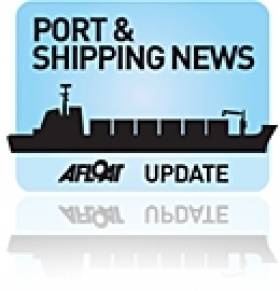Displaying items by tag: Contraband Cigarettes
#GigaretteSeizedShips – This week's seizure of €14m in contraband cigarettes, the biggest haul in Europe so far this year from the M.V. Shingle in Drogheda Port and subsequent unloading in Dublin Port, echoes similarities to another major haul that took place a few years back.
The latest haul of 32m cigarettes including tobacco had been loaded in Slovenia on board the 667 tonnes Slovenia. However a considerably larger cargo of contraband totalling 120m cigarettes and worth €40m had taken place in 2009, then forming the largest ever cigarettes seizure to occur in the EU.
On that occasion, the larger 2,528 tonnes container-general cargoship M.V. Anne Scan had travelled much further to reach Ireland, having crossed the oceans from the Philippines.
The massive haul was carried out in another Co. Louth port, that been Greenore on Carlingford Lough. Likewise of the Shingle, she too was escorted by a Revenue Commissioners custom cutter, RCC Faire to Dublin Port where unloading took place also in Alexandra Basin.
The apprehending of both these vessels has potentially saved huge revenue otherwise lost at the expense of the Irish and UK exchequer.
Such high-profile hauls are a major coup for the multi-faceted agencies here in Ireland, the UK but also the EU's anti-fraud agency OLAF and global counterintelligence agencies.
In order to carry out such operations in Irish waters, this is where the Revenue Commissioners customs cutters have performed their role with co-operation of the Naval Service and the Gardai.
RCC Suirbheir an almost identical customs cutter of RCC Faire was also involved in the apprehending of the Shingle having also carried out escort duties on the passage between Drogheda and Dublin Port, from where the contraband was unloaded.
In addition further detailed technical examination was able to take place alongside Ocean Pier within Alexandra Basin west.
It would be the seizure of Anne Scan which saw the then brand new RCC Faire as mentioned above become involved in her first major task. She had only entered service for just over a week in late October 2009.
The Finnish built 23m cutter costing €2.6m was assisted by the Naval Service which deployed OPV L.E. Niamh (P52) to discreetly follow the transit of Anne Scan as she headed through the Irish Sea.
Her elder sister RCC Suirbheir was introduced in 2004 and she became the first custom-built vessel for the Revenue service since the foundation of the Irish Free State in 1922.
Capable of 25 knots, the cutters are equipped with an array of surveillance systems and use of a 38-knot RIB's to provide rapid response and added coverage as well to boarding vessels.
New series of 'Customs' on RTÉ One
To be broadcast in six-parts, the series will provide unprecedented access into the daily operations of the custom officers.'Customs' examines how the country is dealing with increasing levels of illegally imported materials and substances.
Custom officers found shipments of drugs in the strangest places: a doll's house,picture frames, the bottom of a massive cargo ship. In addition the seizure of contraband cigarettes, vehicles, large quantities of money and the more bizarre discovery of a Colombian snake.
























